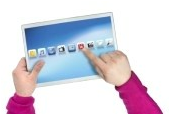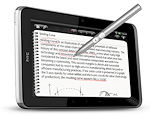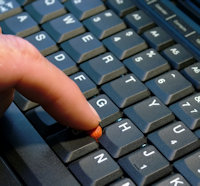Jan's Computer Basics:
Input: Pointing Devices
A variety of pointing devices are used to move the pointer  on the screen.
on the screen.
A mouse or trackball will have two or three buttons to click for special actions. Touchpads and touchscreens use taps and swipes with various numbers of fingers for special actions. A pointing stick is a tiny joystick in the middle of a laptop keyboard.
Mouse
|
  Old type: A ball underneath rolls as the mouse moves across the mouse
pad. Old type: A ball underneath rolls as the mouse moves across the mouse
pad.
New type: A laser
shines on the surface under the mouse to detect the motion of the mouse. High tech! No mouse pad is needed if the surface is smooth but has variation in color or texture.
The pointer on the screen follows the motion of the
mouse. Buttons on the mouse can be clicked or double-clicked
to perform tasks, like to select an icon on the screen or to
open the selected document.
 Many
recent mice have a scroll wheel as the middle button. Many
recent mice have a scroll wheel as the middle button.
Wireless mice are very popular. No cord to deal with - just batteries.
 Practice clicking on the images of mice above. The image will change
with a successful click. Practice clicking on the images of mice above. The image will change
with a successful click.
|
|
| Advantage: |
- Moves pointer around
the screen faster than using keystrokes.
|
| Disadvantage: |
- Requires moving
hand from keyboard to mouse and back.
- Repeated motion is tiring and can
lead to carpal tunnel syndrome
|
|
Trackball
|
Instead of moving the whole mouse around, the user rolls the trackball only, which is on the top or side.
|
|
| Advantage: |
- Does not need as much desk space as a mouse.
- Can be used away from flat surfaces.
- Less strain since less motion is needed.
- Allows continuous motion without having to reposition.
- Good for users with mobility impairment.
|
| Disadvantage: |
- Requires fine control of the ball with just one finger or thumb.
- Repeated motions of the same muscles is tiring and can cause carpal tunnel syndrome.
|
|
Touchpad |
A finger on a touch sensitive pad controls the pointer. The user slides a finger across the pad and the pointer follows the finger movement. For clicking there are buttons, or you can tap on the pad with a finger. Most laptops have a touchpad.
Some touchpads come with software that creates special actions, like scrolling when a finger drags down the right side of the touchpad. |
|
| Advantage: |
- Does not need as much desk space as a mouse since it does not move.
- Can readily be built into the keyboard.
- Has finer resolution. That is, to achieve the same movement onscreen takes less movement of the finger on the touchpad than it does movement of the mouse.
- Can use either buttons or taps of the pad for clicking.
|
| Disadvantage: |
- The hand tires faster than with a mouse since there is no wrist or hand support.
- Some people don't find the motion as natural as a mouse.
|
|
Pointing Stick
|
A pointing stick is a small joystick with a pressure sensitive nub about the size of a pencil eraser. The user pushes the nub around (not pressing it down) to make the pointer move in that direction. More pressure makes the pointer move faster.
A pointing stick is usually on the keyboard of a laptop between the G, H, and B keys.

Credit: Lenovo
A pointing stick needs either a touchpad or separate keys to create clicks like the left and right mouse buttons. |
|
| Advantage: |
- Can readily be built into the keyboard.
- Fits onto very compact keyboards that cannot hold a touchpad.
- User does not have to move hands from the keyboard to use the pointing stick.
- Allows continuous motion without having to reposition.
- Some users think they get finer control of the pointer position.
|
| Disadvantage: |
- Index finger may suffer from overuse.
- Finger can slip off the pointing stick and press keys accidentally.
- Applying high pressure can cause hand cramps, etc.
|
|
Touchscreen |
 Make selection by just touching the screen with a finger or stylus. Some touchscreens allow multi-finger gestures. Make selection by just touching the screen with a finger or stylus. Some touchscreens allow multi-finger gestures.
Used on smart phones, tablets, and screens in some larger devices like ATMs and gas pumps. |
|
| Advantage: |
- It's natural to do - reach out and touch something.
- Works without extra hardware.
|
| Disadvantage: |
- It's tiring if many choices must be made.
- It takes a lot of screen space for each choice since fingers are bigger than cursors.
|
|
Pen Input
|
  Used esp. in Personal Digital Assistants (PDA) and some tablets and smart phones. Used esp. in Personal Digital Assistants (PDA) and some tablets and smart phones.
The pen is also called a stylus.
Pen Input is used for:
|
|
| Data Input - |
By writing. Optical Character Recognition reads your handwriting and turns it into text. (If only your friends could read your handwriting, too!)
By drawing. Graphics tablets create a picture with your pen strokes. |
| Pointing Device - |
Functions like a mouse in moving a pointer around the screen and clicking by tapping the screen. |
| Command Gestures - |
You can issue commands by moving the pen in patterns. So a certain kind of swirl would mean to save the file and a different kind of swirl could mean to open a new file. |
|
|
| Advantage: |
- Can use handwriting instead of typing. Better for taking notes.
- Can use gestures instead of typing commands. Faster.
- Small size of device.
- Easier to draw with a stylus than with a mouse.
|
| Disadvantage: |
- May have to train device to recognize handwriting.
- Must learn gestures or train device to recognize the ones you create
- Can lose the pen, which is not usually permanently attached to the device
|
|
Game Devices |
Pointer position is controlled by a joystick or with arrow buttons.
|
|
| Advantage: |
- A joystick gives a more natural-feeling control for motion in games, especially those where you are flying a plane or spaceship.
- Has more buttons for special functions than a mouse and can combine buttons for even more actions.
|
| Disadvantage: |
- More expensive
- Bulky
- Specialized, so you may need different devices for different programs or games.
- Better ones require an additional peripheral card for best performance
|
|
![]() on the screen.
on the screen. 













 Make selection by just touching the screen with a finger or stylus. Some touchscreens allow multi-finger gestures.
Make selection by just touching the screen with a finger or stylus. Some touchscreens allow multi-finger gestures.
 Used esp. in Personal Digital Assistants (PDA) and some tablets and smart phones.
Used esp. in Personal Digital Assistants (PDA) and some tablets and smart phones.